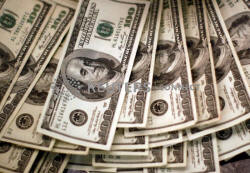Dollar rally resumes as U.S.-China tensions escalate;
Swiss franc falls
 Send a link to a friend
Send a link to a friend
 [August 10, 2020] By
Elizabeth Howcroft [August 10, 2020] By
Elizabeth Howcroft
LONDON (Reuters) - The dollar strengthened
on Monday, including against the euro and the Swiss franc, as investors
focused on fiscal stimulus in the United States and U.S.-China tensions
ahead of key trade talks on Aug. 15.
The dollar index is recovering from a losing streak which saw it lose 4%
in July. It picked up on Friday after jobs data calmed some fears about
the U.S. labor market but still weakened on the week, for the seventh in
a row.
After talks in Washington over the next round of fiscal stimulus broke
down, U.S. President Donald Trump signed executive orders on Saturday,
partially restoring enhanced unemployment payments to tens of millions
of jobless Americans.
The dollar index held steady in the Asian session but rose in early
London trading on Monday, and was up 1% at 93.532 at 1008 GMT.
"A little stimulus is simply better than none at all," wrote Commerzbank
analyst Thu Lan Nguyen.

"At least that is how the market seems to see it, which is why the U.S.
dollar is trading moderately stronger," she added.
Speculators increased their net short dollar positions in the latest
week, according to weekly futures data on Friday.
The dollar's strength at the end of last week was also due to escalating
tensions between the United States and China, with the U.S. imposing
sanctions on top Hong Kong and Chinese officials.
This continued to drive investors towards the safe-haven dollar on
Monday. China imposed sanctions on 11 U.S. citizens, including
legislators.
Prominent democracy activist, Hong Kong media tycoon Jimmy Lai, was
arrested on Monday under China's new national security law in the
territory, while U.S. health chief Alex Azar visited Taiwan on Sunday -
a trip condemned by China which claims the island as its own.
Senior U.S. and Chinese officials will meet via teleconference on
Saturday to review the implementation of their Phase 1 trade deal and
likely air mutual grievances.
The euro was down 0.2% versus the dollar, at $1.17605.
[to top of second column] |

Four thousand U.S. dollars are counted out by a banker counting
currency at a bank in Westminster, Colorado November 3, 2009.
REUTERS/Rick Wilking/File Photo/File Photo

The Swiss franc fell versus the dollar, down 0.4% at 0.9159. Euro-franc was up
0.2% at 1.0773.
The Swiss National Bank sight deposits rose in the week ending Aug. 7. A rise in
sight deposits can indicate central bank intervention in foreign exchange
markets to weaken the franc.
"It looks then like Europeans are buying euros vs their currencies, particularly
vs CHF, while the U.S. is buying EUR/USD," wrote Marshall Gittler, head of
investment research at BDSwiss Group.
Overnight data showed China’s industrial activity picked up in July, boosting
hopes for an economic recovery and driving early gains in European stocks.
The Norwegian crown gained versus the dollar, up around 0.4% at 9.0285.
The New Zealand dollar was down 0.2% versus the dollar, at 0.6585.
The Australian dollar was subdued, down 0.1% versus the U.S. dollar at 0.71525
after the country recorded a record-high daily increase in COVID-19 deaths on
Monday. Prime Minister Scott Morrison said internal border closures were
unlikely to be lifted before Christmas.
Australia's central bank downgraded its outlook for the national economy on
Friday and warned unemployment would stay high for several years.
Graphic: World FX rates in 2020
https://graphics.reuters.com/
GLOBAL-CURRENCIES-PERFORMANCE/
0100301V041/index.html

Graphic: U.S. Dollar Index & CFTC Positions
https://fingfx.thomsonreuters.com/
gfx/mkt/jznpnkgkdvl/Pasted%20image%201596831755664.png
(Reporting by Elizabeth Howcroft; Editing by Kirsten Donovan and Susan Fenton)
[© 2020 Thomson Reuters. All rights
reserved.] Copyright 2020 Reuters. All rights reserved. This material may not be published,
broadcast, rewritten or redistributed.
Thompson Reuters is solely responsible for this content. |